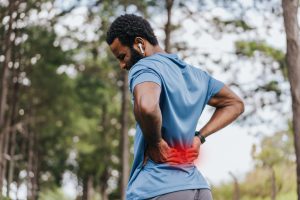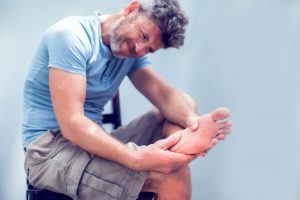Intrathecal Pain Pump
An intrathecal drug pump, commonly called a pain pump, is a small device that is implanted in the abdomen. A pain pump injects small doses of medication directly into the spinal cord.
There are a number of advantages to this approach and it can help certain patients find relief from chronic pain. It also can reduce some potential side effects of oral medication.
We’ve provided the following information on this procedure to help patients make a treatment decision that matches their needs and lifestyles. To find out more about our procedures, the conditions we treat, or our medical team, you can get in touch with our team at any time.
Who Receives Pain Pumps?
Pain pumps are generally recommended for patients with moderate to severe pain who have completed a full course of initial pain management, but who are not candidates for more extensive spine surgery.
Because the pump device allows for a controlled release of medication directly to the spinal cord, it can offer much greater pain relief without the larger doses required from medication taken by mouth.
Because the spinal cord is the main path of the nervous system, pain pumps offer relief for symptoms caused by a wide range of conditions and injuries, including:
- Spinal cord injuries
- Brain injury and stroke
- Arachnoiditis is a form of inflammation around the brain and spinal cord
- Cancer pain
- Failed back surgery syndrome (FBSS)
Patients who are candidates for pain pump procedures will undergo an initial trial to ensure this is an effective form of treatment.
Conditions
Before implanting the device permanently, surgeons will first attempt a trial to determine effective dosage and placement. Methods can include one or more direct injections of the medication or a catheter connected to an external pump.
The procedure to implant a pump permanently is performed on an outpatient basis and involves the following steps:
- The surgeon makes two small incisions, one in the back and one in the abdomen
- The surgeon first places the catheter on the spinal cord
- He or she then implants the pump into the abdominal cavity.
Upon recovery, patients receive discharge and incision care instructions from the medical team.
Pain pumps require periodic refills and maintenance from your surgeon. At these visits, patients can report the effectiveness of the medication and work to adjust the dosage. The objective is to find a minimum dose that offers meaningful pain reduction and improved mobility.
Cost for Pain Pump Procedure
The cost for the trial and implant of a pain pump can vary depending on factors such as the type of procedure required, the location of the pump, and the method of payment. Medicare will typically cover therapeutic injections if they are deemed necessary by a physician and administered by a qualified professional. BEST Health System facilities accept patients with Medicare, most private health insurances, as well as workers’ compensation and personal injury cases. One of our representatives can answer any questions you have about cost.
Pain pumps successfully help a large number of patients dealing with chronic pain, muscle spasms, and other symptoms reclaim their lives. At BEST Health System, our board-certified surgeons have extensive experience performing this outpatient procedure.
If you’d like to learn more, please contact our dedicated team today.
Procedure Doctors
Related Articles
Finding Relief from Complex Regional Pain Syndrome
Most Common Symptoms of Complex Regional Pain Syndrome Complex regional pain syndrome, sometimes referred to as CRPS, is a chronic condition that causes patients to […]
How To Know If I Have Neuropathy
Understanding Neuropathy Neuropathy, also known as nerve damage, is a common condition that affects a range of patients. When nerves are damaged, they cannot successfully […]
Understanding Phantom Limb Pain
What is Phantom Limb Pain? Phantom limb pain is a complex condition that affects patients who suffered a traumatic injury that resulted in them having […]
Four Reasons Why Complex Regional Pain Syndrome Develops
Understanding Complex Regional Pain Syndrome Complex regional pain syndrome, CRPS, is a common condition that affects a variety of patients. Patients with CRPS may experience […]
Natural Remedies for Neuropathy Treatment
Understanding Common Neuropathy Symptoms Neuropathy manifests various symptoms – from tingling and numbness sensations to muscle weakness and balance difficulty. It is important for patients […]
Tips for Managing Complex Regional Pain Syndrome
Understanding Complex Regional Pain Syndrome (CRPS) Complex regional pain syndrome (CRPS) is a nerve-related condition that causes patients to experience debilitating pain in a singular […]
Why Some Cancer Patients Develop Neuropathy
Understanding Neuropathy Neuropathy, also known as nerve damage, is a common condition that affects the peripheral nervous system. Patients with this condition often experience debilitating […]
Understanding What Causes Failed Back Surgery Syndrome?
Understanding Failed Back Surgery Syndrome Failed back surgery syndrome can occur for several reasons. In some instances, there’s one, easy-to-identify issue, while in others, there’s […]
Diabetic Neuropathy Treatment Options
Living with Diabetic Neuropathy Painful diabetic neuropathy is a common condition that many diabetes patients suffer from. Neuropathy, commonly referred to as nerve damage, can […]
FAQs about Phantom Limb Pain
Understanding Phantom Limb Pain Phantom limb pain is a chronic condition that affects patients who have recently had an amputation. Patients with this condition often […]
Spinal Cord Stimulation Therapy for Failed Back Surgery Syndrome
How Spinal Cord Stimulation Therapy Works Spinal cord stimulation therapy is a common treatment option recommended to patients who suffer from debilitating chronic pain as […]
At-Home Therapies to Minimize Chronic Pain
Understanding the Severity of Chronic Pain Chronic pain is a common condition that affects a large range of patients for various reasons. This type of […]













